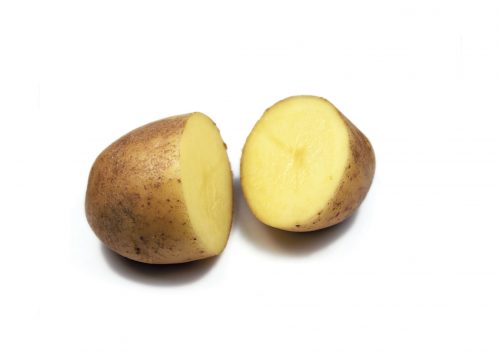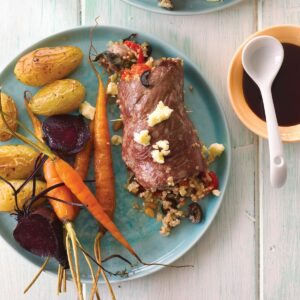
Potatoes are our most popular vegetable. And they are so good for us!
The original potato, grown in high altitudes in South America over 2000 years ago, was small, misshapen, knobbly and bitter-tasting.
Thankfully such trifles did not deter the tough peoples of the Andes and, presumably recognising their nutritional value, they learned how to transform these ugly little tubers into something edible.
Over time and continents these early potatoes were cultivated into the (tasty and good looking) vegetable that became a staple food around the world.
Varieties
There are over 50 potato varieties grown in New Zealand but only about a dozen that are commonly available.
Potatoes are often described as ‘floury’ or ‘waxy’, depending on their texture.
Floury potatoes – like Agria or Red Rascal – are better for mashing and baking but don’t hold their shape as well for salads.
Waxy potatoes – like Nadine or Draga – are better for boiling, salads and in casseroles as they retain their shape and don’t fall apart.
Some potatoes – like Rua or Desiree – are in between and can be used for pretty much anything.
Note that the texture of some varieties can change throughout the season.Ilam Hardy is the extreme example of this: it’s quite waxy in October but by the end of the season in February, a lot more of the sugars have converted to starch and they can be floury.
Potato nutrition
A medium-sized, unadulterated, boiled potato (135g serve) provides around 25g carbohydrate, 3g protein and 0.2g fat.
It will also provide around 3g fibre, a range of antioxidants including vitamin C, as well as useful amounts of some B vitamins.
Yellow-fleshed or red skinned varieties are higher in antioxidants.
For maximum nutrition from any potato, leave the skin on: the skin and the layer immediately underneath contain both fibre and antioxidants. When boiled potatoes are cooled, some of the starch changes to provide additional fibre.
Potatoes are naturally a low-fat food but they only stay that way if you don’t add any fat! Look at how the fat content changes when you take a 135g serve of ‘potato’ presented in different ways:
| Cooking method | Fat |
|---|---|
| Baked, boiled or microwaved (served naked) | <1g |
| Mashed with butter and milk | 4g |
| Roasted in oil | 7g |
| Wedges | 9g |
| Scalloped with cheese | 10g |
| Standard chips from the fish ‘n chip shop | 13g |
| Shoestring fries | 19g |
| Potato chips | 30-40g |
Potatoes have a high ‘satiety value’, which means they are filling and you feel more satisfied between meals than foods with lower satiety.
What about GI?
The glycaemic index (GI) ranks carbohydrates based on their immediate effect on blood glucose (blood sugar) levels. Foods that are high-GI raise the blood glucose levels more quickly than low-GI foods.
Most potatoes have a high-GI value, although potatoes vary between varieties from a moderate 56 (new potato) to a high 101 (Desiree).
The method of cooking and the type of potato can also affect its GI; boiled potatoes (especially when served cold) are lower GI than mashed, and new waxy potatoes are generally lower GI than floury ones.
The glycaemic impact of any food relates to the amount eaten, so a larger portion will have a larger impact.
While the GI can be a useful tool, not all of the foods you eat need to be low-GI and potatoes remain an important and healthful part of our diets.
Storage
Potatoes may look tough but they can bruise easily, so handle them with care. Potatoes keep best when stored in a cool dark place. If the temperature is higher than 8-10°C they will sprout, and if it’s cooler the flavour will change (so never store them in the fridge).
A heavy paper bag or cardboard box is an ideal storage container to keep out the light. When they are exposed to light for prolonged periods potatoes develop a green colour from the formation of chlorophyll, which is a harmless pigment.
However, a toxin called solanine is produced simultaneously, so the chlorophyll is a useful indicator.
If there is only a small amount of greening it can be trimmed and the remaining potato used – the solanine production occurs near the skin just like the chlorophyll – but don’t eat a green potato.
New potatoes are very susceptible to greening, so it may be easier to buy smaller quantities rather than storing them.
Did you know?
- Over 1 million people died and another million left the country during the Irish potato famine, which lasted six years from 1845, after ‘the blight’ destroyed their staple food supply almost overnight.
- ‘Lite’ potato chips are named for their cut NOT their fat content. Don’t be fooled!
- In the US potato chips (or ‘crisps’) are commonly served on the side with a sandwich or burger. (They may be able to fool themselves that they’re eating vegetables by doing this but I think most Kiwis would know better!)
- Potatoes can get a disease called ‘hollow heart’ which gives them a hole in the centre.
www.healthyfood.com










